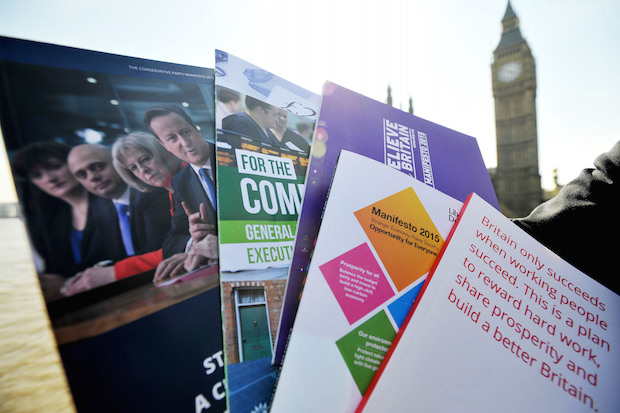Nobody’s perfect, are they? The IFS found something to criticise today for all the parties — the Conservatives, Labour, Lib Dems and SNP — whose tax and spending plans it has examined.
The main charges are of leaving questions about spending and borrowing unanswered: The Conservatives ‘have not been completely explicit about exactly what level of borrowing they would want to achieve’ and nor have the SNP, Labour has ‘provided disappointingly little information on what they would borrow’. There’s a gold star for the back of the Lib Dems’ exercise book: they have been ‘more transparent’ about their fiscal plans than other parties, but they get a rap on the knuckles too for saying that ‘largely unspecified’ anti-tax avoidance and evasion measures (it’s the new ‘cracking down on waste and inefficiency’) would contribute to closing the deficit. What else did we learn?
1. We know very little about Labour’s borrowing plans
They’ll balance the cyclically-adjusted current budget – but they won’t say when. They’d borrow to invest – but they won’t say how much. It could mean just £1bn of cuts to departmental spending after this year – or a whole lot more.
2. The SNP plan: austerity for longer – and less money for Scotland
It won’t be as severe, but the SNP’s austerity will have to go on for longer for the party to meet the fiscal rules it has set itself, the IFS says. And its promised splurge on social security would mean that departmental spending would have to stay at last year’s level (in real terms) until 2019-20. If that’s the case, the block grant which funds the Scottish Parliament’s spending would have to be cut. It adds up to a ‘considerable disconnect’ between Nicola Sturgeon’s promised alternative to austerity and the SNP’s stated spending plans.
[datawrapper chart=”http://static.spectator.co.uk/MoO19/index.html”]
3. Only the Tories would balance the books – and cut total spending after this year
All the parties have said they would reduce government borrowing – but on the IFS’s assumptions only the Tories would run an overall budget surplus. Just one problem: they won’t say how they’d do it. The IFS says ‘the Conservatives’ detailed tax policies amount to a net giveaway, their detailed social security measures would only provide a tenth of the cuts that they have said they would deliver, and their commitments on aid, the NHS and schools would increase spending in these areas’. The party’s plans need £5bn raised from tax avoidance measures, £10bn from benefit cuts and £30bn cuts to departments. The NHS, education and foreign aid are protected – so the axe needs to cut 17.9 per cent off the budgets of vulnerable departments.
They’re also the only party that would have total government spending fall after this financial year ends. For all the other parties, it would rise:
[datawrapper chart=”http://static.spectator.co.uk/Uz3mZ/index.html”]
4. The Lib Dems want to shake the magic money tree
The Lib Dems are swinging for the centre ground, putting themselves between the Conservatives and Labour: on spending, on cutting, on taxing (but they’re closest to Labour on all three). But one measure where they’re on the extreme end is the amount they want to from unspecified anti tax-avoidance measures – £10bn, twice as much as the Conservatives, and a third more than Labour.






Comments